Introduction
Static and dynamic code analysis are two essential techniques in software development that help ensure code quality, reliability, and security. Static code analysis functions as a meticulous proofreader, examining source code without execution to identify potential defects, vulnerabilities, and coding standard violations. It serves as a proactive diagnostic tool that enhances software performance and security.
Meanwhile, dynamic code analysis observes code behavior during runtime, providing insights into performance issues, runtime errors, and memory management. These analysis methods are indispensable in the modern software development landscape, where efficiency and reliability are paramount.
In this article, we will explore the key differences between static and dynamic code analysis, the advantages and disadvantages of each approach, and their use cases in various industries, with a focus on the banking sector. We will also discuss the tools available for static and dynamic code analysis, highlighting their unique features and benefits. Furthermore, we will compare the accuracy and performance of these analysis tools and provide best practices for leveraging both static and dynamic analysis effectively.
By understanding the benefits and outcomes of using code analysis tools like Kodezi, developers and organizations can achieve maximum efficiency and productivity in their software development process. So let's dive into the world of static and dynamic code analysis and discover how they can help us create robust, efficient, and secure software solutions.
What is Static Code Analysis?
Static code analysis is akin to a meticulous proofreader for source code, thoroughly examining it without the need for execution. It's a proactive diagnostic tool that sifts through code to pinpoint potential defects, vulnerabilities, and instances where coding standards are not adhered to. These tools dissect the structure, syntax, and logic within the code, flagging issues such as memory leaks, null pointer dereferences, and security loopholes.
For instance, consider the transformative digital shift in the banking sector, where companies like M&T Bank are navigating the complex digital landscape. They face the necessity of adopting clean code standards across their organization to maintain and enhance their software's performance, reliability, and security. In a sector where the stakes include sensitive data protection and stringent regulatory compliance, the cost of deploying problematic software ranges from financial losses to reputational damage. Static code analysis serves as a critical checkpoint to avert such risks by ensuring code quality before deployment.
Moreover, companies are opting for static analysis tools that can be integrated into their own CI environments, as highlighted by Datadog's approach, which offers greater control over the analysis process and bolsters both security and performance. This shift in tool utilization underscores the evolving requirements of modern software development practices.
The importance of these tools is further underscored by the insights of professionals like Jérôme Laban, who emphasize the role of formal methods in bolstering software engineering. Expert opinions point to the cost-effective nature of such methods, which, when applied early, can reduce the need for rework and ensure resource optimization.
The collective wisdom from industry research and case studies suggests a clear guideline for developers and organizations: to select static analysis tools judiciously, cognizant of their ability to enhance software quality and reliability. With the continuous improvement of these tools, they become indispensable allies in the quest to craft robust, efficient, and compliant software systems.
What is Dynamic Code Analysis?
Dynamic code analysis is a powerful technique used during the software development process to observe code behavior while it's running. This approach is invaluable for spotting issues that static code analysis might miss, such as memory leaks, performance hitches, and problematic error handling. It simulates real-world operating conditions, providing developers with a clear picture of how their code will function under various scenarios.
Real-life applications of dynamic analysis include managing complex tasks that software engineers commonly face. For instance, it aids in addressing unexpected test case failures by monitoring runtime errors and exception stacks that may arise from logical mistakes. Moreover, dynamic analysis tools can be pivotal when the output of code deviates from the expected results, even when explicit error messages are absent, thus highlighting the discrepancies for further investigation.
Recent advancements in technology, like the development of large language models and intelligent agents, have further enhanced the capabilities of dynamic code analysis. These tools can now better understand the context and autonomously operate within the software environment, leading to more efficient problem-solving and code optimization.
Verification and system quality are integral to software development. Dynamic code analysis assists in verifying that the software adheres to its requirements and purpose. It examines the design and implementation stages to ensure the system's reliability and dependability. As part of system quality analysis, dynamic code analysis evaluates individual units of code, such as functions or classes, to ensure optimal system operation.
Finally, the impact of dynamic analysis on software quality is significant. It can lead to a reduction in churn code and promote better code reuse practices. By integrating dynamic analysis tools into the development workflow, technical leaders can effectively measure and enhance their team's code quality, ensuring the delivery of robust and reliable software solutions.
Key Differences Between Static and Dynamic Code Analysis
Static code analysis (SCA) and dynamic code analysis serve as two pivotal approaches to ensuring software quality, each with distinct methodologies and scopes. SCA scrutinizes code without running it, enabling developers to evaluate the entire codebase for issues related to structure and syntax. In contrast, dynamic analysis involves executing the code, zeroing in on specific use cases to identify runtime errors and performance issues.
For instance, M&T Bank, a venerable institution with over 165 years of history, has faced the challenges of a digital transformation within the banking industry. To meet the stringent security and regulatory demands that come with handling sensitive data, M&T Bank instituted Clean Code standards to maintain and enhance the performance and security of their software. This strategic move underscores the importance of SCA in minimizing maintenance time and costs while ensuring efficiency and reliability.
Synopsys, a leader in the SAST market recognized by The Forrester Wave™, emphasizes the necessity of SCA in today's development landscape. Their Coverity® SAST solution is lauded for its superior detection capabilities and integration with DevSecOps workflows, highlighting the critical role SCA plays in a system's overall quality.
Quality, as outlined by experts, is the sum of a system’s measurements, encompassing trustworthiness, dependability, and resilience. By understanding these quality factors, organizations can optimize their systems to their operational environments. SCA tools contribute significantly to this quality culture, enabling teams to address issues before they escalate into costly errors or security risks.
The adoption of SCA tools into a company's workflow is not just a technical decision but a strategic one that influences the entire quality culture. As industries like banking rapidly adopt new technologies, the integration of SCA becomes a cornerstone for maintaining a competitive edge, achieving regulatory compliance, and delivering secure, high-quality software to customers.
Advantages of Static Code Analysis
Static code analysis is a powerful asset in the software development lifecycle, offering multifaceted benefits that streamline the development process and enhance the quality of the final product. It provides early detection of issues, often spotting potential problems before they escalate. This preemptive approach significantly reduces the cost and effort required to address bugs later in the development cycle.
Automated analysis is another key advantage. Tools for static code analysis automate the traditionally manual and time-consuming process of code review. This automation not only saves time but also ensures a more objective and thorough examination of the code. As a result, developers can focus on more complex tasks that require human insight.
Consistency in code quality is maintained through the enforcement of coding standards and best practices. Static analysis tools serve as vigilant gatekeepers, ensuring that all code adheres to predefined quality benchmarks, thereby maintaining a high standard across the entire project.
One of the paramount concerns in software development is security. Static code analysis addresses this by detecting security vulnerabilities early in the development process. This empowers developers to fortify the code against potential threats and aligns with the rigorous security and regulatory demands of industries such as banking, where companies like M&T Bank have adopted clean code standards to safeguard their digital transformation.
In summary, static code analysis is an indispensable practice for modern software development, contributing to the reliability, security, and maintainability of code, and supporting the overall quality culture within development teams.
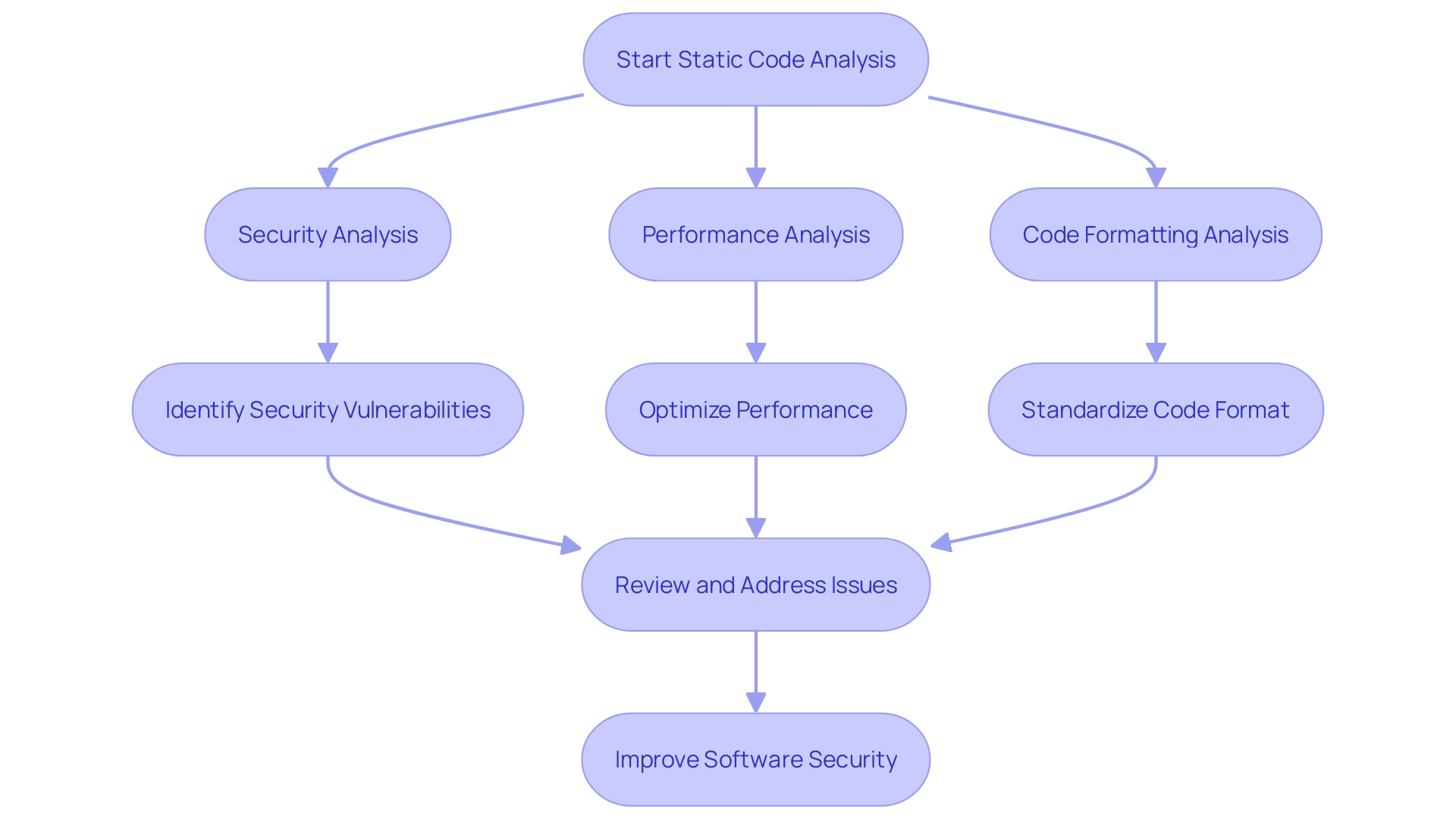
Advantages of Dynamic Code Analysis
Dynamic code analysis serves as a powerful tool in a developer's arsenal, offering critical insights into the behavior of software under actual operating conditions. Through this technique, developers can replicate different user environments and observe how code performs, a method that M&T Bank found invaluable as they sought to uphold their Clean Code standards amid a digital transformation in the banking sector.
One major advantage of dynamic analysis is its capacity to pinpoint performance issues. It scrutinizes the software as it runs, identifying bottlenecks that impede efficiency, allowing for targeted optimizations that can significantly enhance the software's responsiveness and speed.
Moreover, dynamic code analysis is indispensable in detecting runtime errors that might not surface during static analysis. These can include unhandled exceptions and other anomalies that, if unaddressed, can disrupt user experience or lead to software crashes. By catching these issues early, developers can fortify their applications against potential failures.
Another critical aspect is memory leak detection. Dynamic analysis monitors the application's resource usage, revealing leaks that can lead to sluggish performance or system instability over time. For institutions like M&T Bank, where software reliability is paramount to safeguard sensitive financial data, such vigilance is essential to maintaining trust and compliance.
In the rapidly evolving world of software development, where Agile methodologies emphasize rapid iteration and continuous delivery, the role of dynamic code analysis is ever more prominent. It not only supports the creation of robust and secure applications but also aligns with preventive programming practices, reducing the time spent on debugging and reinforcing the quality culture within development teams.
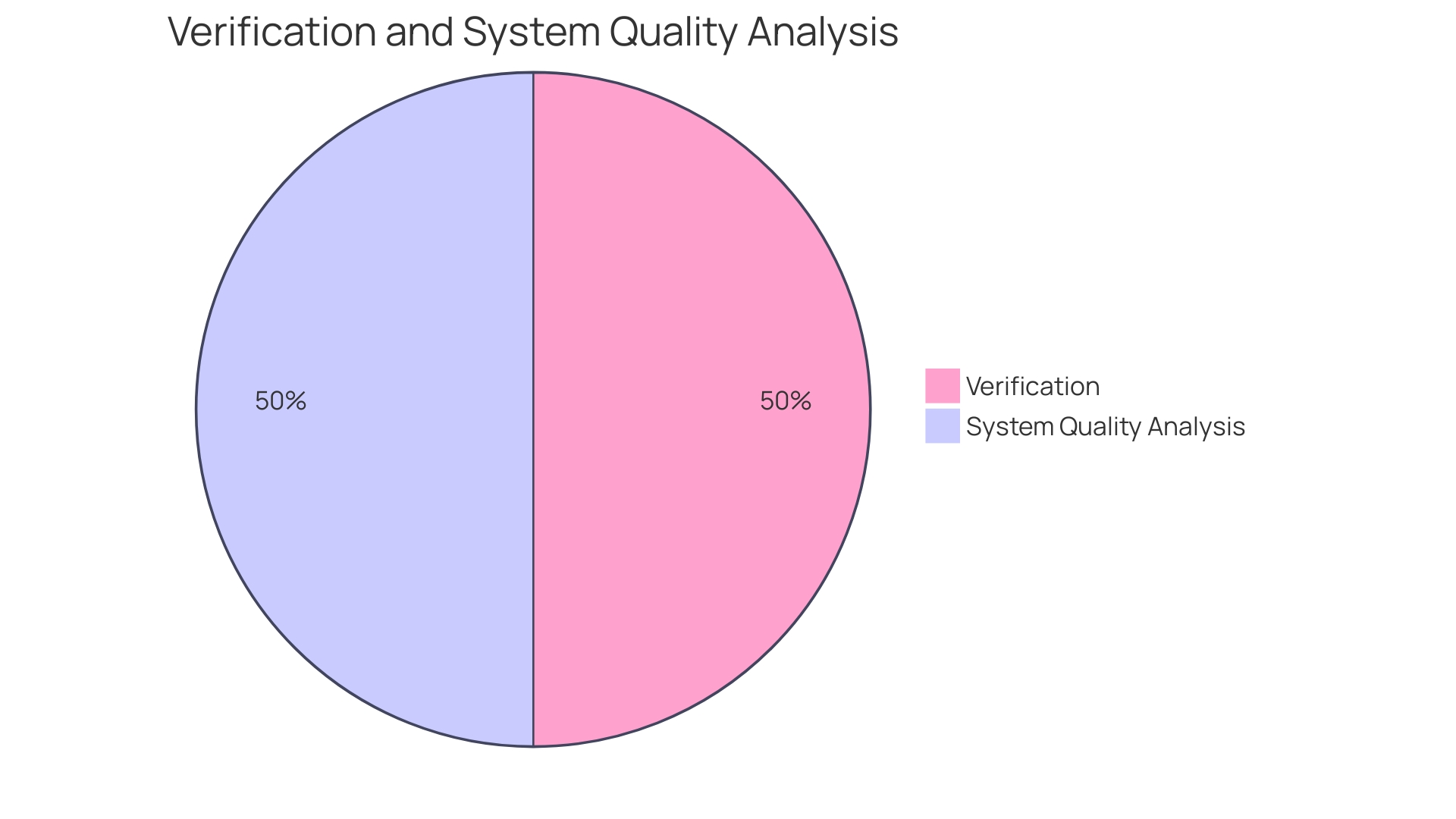
Disadvantages of Static Code Analysis
Static code analysis, while a powerful method for improving software quality, is not without its challenges. It can sometimes incorrectly flag code as problematic (false positives) or miss actual issues (false negatives), which can become a stumbling block for developers. For example, during a validation process in the Moodle learning management system, an analysis tool must ensure that no PHP comments are present in the answer formula. This process can become complex when variables are replaced and naming restrictions are applied.
Another limitation is the lack of runtime behavior insight. Static analysis provides no information on how the code will perform in various runtime environments. This is particularly relevant for complex systems that rely on a multitude of libraries and frameworks, where each component may behave differently under specific conditions.
Moreover, it's crucial to understand that static analysis might not catch every type of issue, particularly those related to intricate business logic or external dependencies. In the context of embedded software, which is fundamental to the operation of systems ranging from vehicles to medical devices, a missed vulnerability could have dire implications for safety. As organizations prioritize security from the get-go, commonly referred to as 'shift left', recognizing the boundaries of static code analysis becomes even more important.
Despite these challenges, the value of static code analysis in maintaining high standards of code quality cannot be overstated. It helps enforce coding standards, such as naming conventions and indentation styles, which is crucial for readability and consistency. Additionally, by examining trends over time, companies can identify which classes of defects are increasing or decreasing, allowing them to focus on improving software quality.
An analysis of static analysis warnings and architectural smells has shown that certain code smells, like 'Magic Number' and 'Long Parameter List', can persist for a long time in software systems. This suggests a need for developers to prioritize addressing issues that are more likely to co-occur with significant architectural concerns. As one industry expert puts it, the goal should be to shift from fixing individual defects to preventing entire classes of defects, thereby shifting the responsibility of security from the least capable to the most equipped.
Understanding these limitations is essential for developers to effectively utilize static code analysis and accurately interpret its results, thereby contributing to the creation of more secure and reliable software.
Disadvantages of Dynamic Code Analysis
Dynamic code analysis, an integral part of the modern software development process, does present certain challenges that developers must navigate. One such challenge is the execution overhead, as this technique involves running the code, which in turn can slow down system performance. Additionally, dynamic analysis might not explore every conceivable code path, which results in limited code coverage and potentially missed defects. Another obstacle is the difficulty in reproducing issues since dynamic analysis may produce bugs that are highly dependent on the specific runtime environment and conditions, making them elusive and challenging to consistently replicate.
In practice, these limitations mean that while dynamic analysis is a powerful tool for identifying runtime issues, it should be used in conjunction with other methods for a comprehensive testing strategy. For instance, the validation function in Moodle's LMS demonstrates the necessity of thorough examination without PHP comments, by substituting variables, and imposing naming restrictions to maintain security. The evolving landscape of software development, including the introduction of new techniques like LLMs, underscores the importance of adaptable and multi-faceted testing approaches that can lead to dramatic performance improvements and increase the chances of industrial adoption.
Use Cases for Static and Dynamic Code Analysis
Static and dynamic code analysis each play a critical role in software development, particularly in high-stakes industries such as banking. For instance, M&T Bank, with its significant history and commitment to quality, has recognized the need for establishing Clean Code standards to ensure software maintainability and performance. Static code analysis shines in several key areas:
-
Continuous integration: By integrating static analysis into the build process, developers ensure that each build meets the high-quality standards necessary for banking software, where the cost of failure is high.
-
Coding standards enforcement: Static analysis tools are instrumental in maintaining consistent code quality across large projects, a necessity for complex banking systems.
-
Security assurance: In an industry where security is paramount, static code analysis helps identify vulnerabilities early, fortifying the code against potential breaches.
Conversely, dynamic code analysis addresses issues that manifest during runtime, including:
-
Performance optimization: It aids in pinpointing performance bottlenecks, crucial for the smooth operation of banking software that handles numerous transactions.
-
Runtime error detection: Dynamic analysis uncovers errors that occur during the application's operation, essential for troubleshooting and ensuring a seamless customer experience.
-
Memory management: It is key to detecting memory leaks and excessive resource consumption, which can destabilize banking software and lead to service interruptions.
By leveraging both static and dynamic analysis, development teams can assure comprehensive code quality, covering everything from security to performance. This approach is essential in an era where, as noted by industry experts, good design means the ability to adapt and change. Fostering an environment where code is not only functional but also resilient and dependable is critical, especially when the digital transformation in banking accelerates and the margin for error narrows.
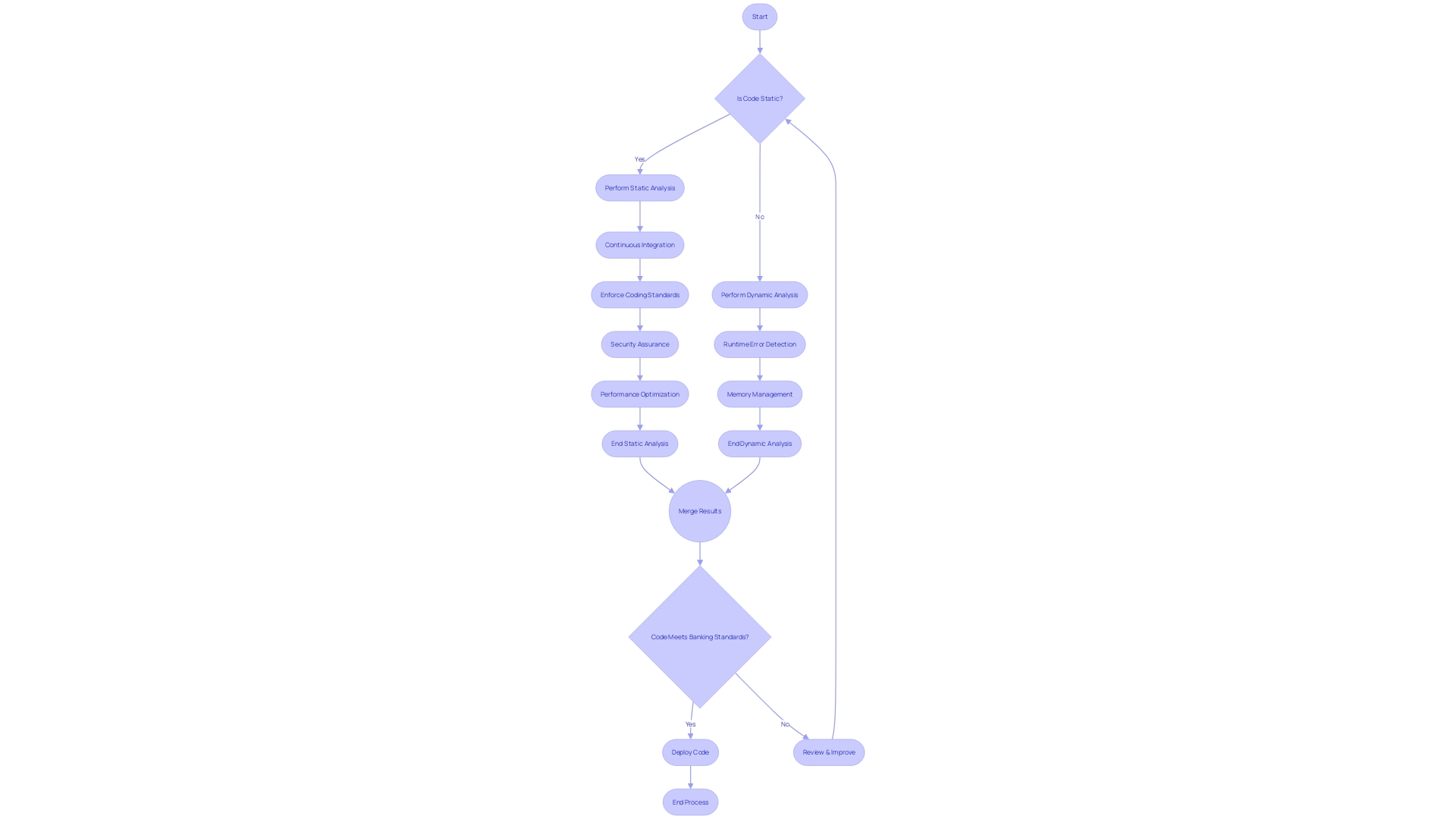
Tools for Static and Dynamic Code Analysis
Delving into the realm of code analysis, developers are presented with a diverse array of tools, each specialized for distinct aspects of the code's lifecycle. Static code analysis tools, such as SonarQube, ESLint, and FindBugs, serve as meticulous examiners of source code, uncovering potential flaws and offering insights to refine the codebase. Meanwhile, dynamic code analysis tools like Valgrind, JProfiler, and Apache JMeter scrutinize the code during execution, pinpointing performance issues, memory leaks, and other runtime anomalies.
Selecting the most fitting tool is contingent upon the project's unique demands and the programming languages employed. For instance, Codiga's analysis tools operate on robust servers, autonomously conducting analyses upon code repository updates, which is particularly beneficial for developers seeking rapid feedback without straining their local resources. Conversely, Datadog's static analyzer runs on users' own CI instances, granting them greater control and potentially enhancing security and performance, albeit at the cost of higher resource demands.
As highlighted by the experiences of developing the 'Mun' analyzer, the choice of tooling can impact both the control over the analysis process and the performance. This is exemplified by Datadog's migration from Java to Rust for their analyzer, which, despite a learning curve, resulted in a more efficient migration due to Rust's performance advantages.
The effectiveness of static application security solutions also plays a critical role, as they must cope with the increasing complexity of applications that depend on an assortment of libraries and frameworks. Comprehensive tools like code scanning provide broad vulnerability coverage, ensuring a meticulous evaluation of the codebase. This level of detail is crucial for identifying vulnerabilities peculiar to specific technologies or development practices, thereby contributing to a more robust security posture.
Ultimately, the integration of static code analysis tools into your workflow should be approached with a clear understanding of the system's quality, its resilience, and trustworthiness. By doing so, you will not only enhance the quality culture within your team but also ensure that your system's behavior is optimized for its operating environment.
Comparing Accuracy and Performance of Static and Dynamic Analysis Tools
Selecting the right code analysis tools is crucial for maintaining software quality, especially in industries with stringent security requirements like banking. Static and dynamic analysis tools each play a unique role in the software development lifecycle, with static tools focusing on code structure and syntax to identify potential issues early in the development process. These tools can be integrated into the build process without impacting runtime performance, offering a comprehensive analysis of the entire codebase.
Conversely, dynamic analysis tools assess the software during execution, providing insights into runtime behavior and pinpointing issues that only surface when the code is running. However, this can introduce performance overhead. The choice between static and dynamic tools should be informed by the desired code coverage and project specifics.
As exemplified by M&T Bank's pursuit of Clean Code standards, the importance of code analysis tools cannot be understated in the digital transformation of the banking industry. Ensuring that the highly sensitive data and transactions are secure is paramount. Static analysis tools, equipped with broad language and framework coverage, can scrutinize all parts of the codebase, identifying a wide array of vulnerabilities and contributing to a robust security posture.
With the high costs associated with software defects—ranging from security breaches to reputational damage—banking organizations must ensure their code meets quality standards and remains compliant. As organizations like M&T Bank have demonstrated, establishing clean code practices and integrating effective static analysis tools are essential steps in minimizing maintenance time, reducing costs, and ensuring the efficiency, reliability, and security of software applications.
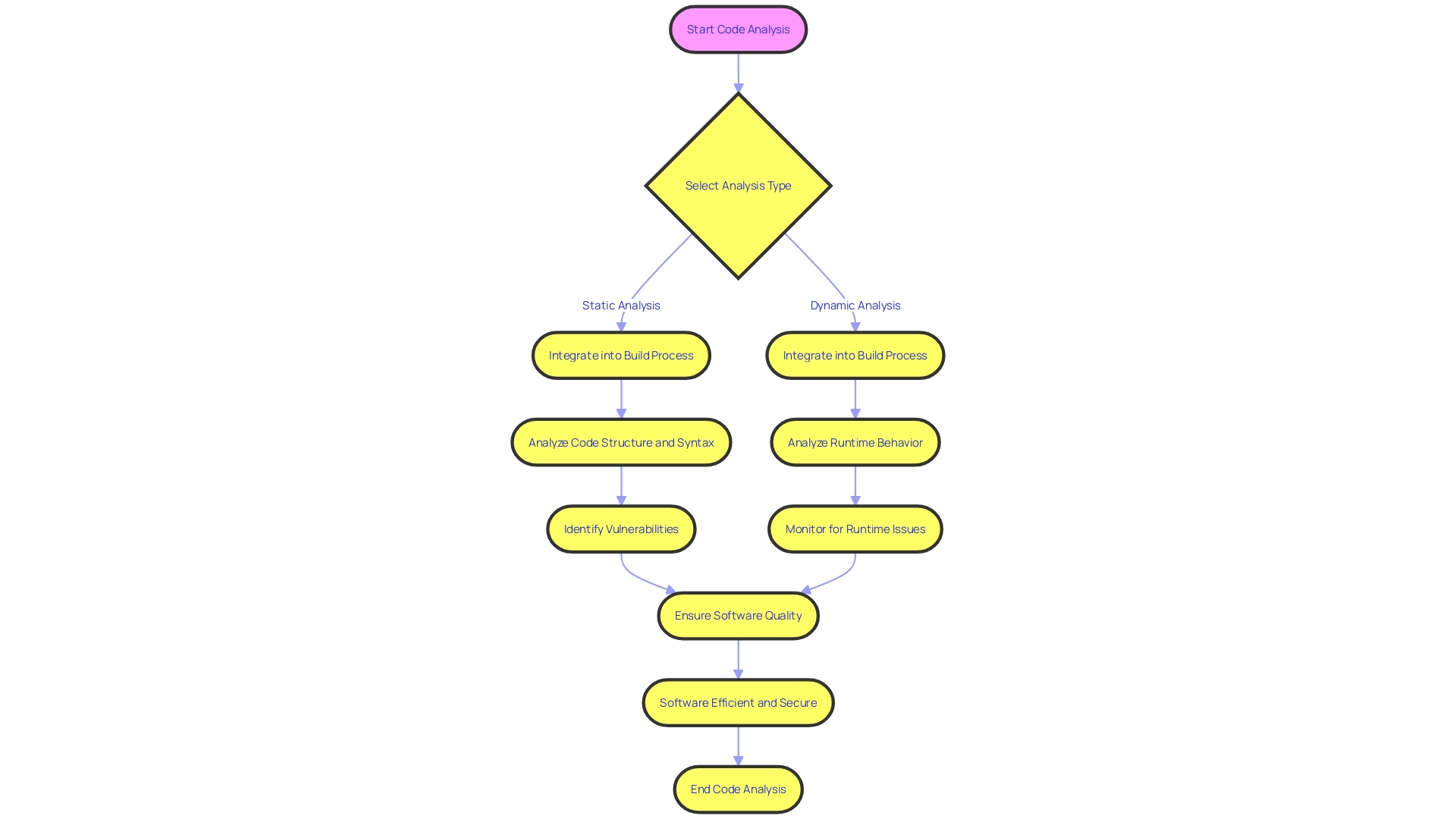
Best Practices for Leveraging Both Static and Dynamic Analysis
To harness the full potential of static and dynamic code analysis, developers are encouraged to adopt a set of best practices that not only bolster code quality but also align with the evolving landscape of software development. Here are some refined strategies:
-
Leverage the strengths of both static and dynamic analysis: Utilizing both methodologies provides a comprehensive inspection of code, helping to uncover a broader spectrum of potential issues. M&T Bank's initiative to establish Clean Code standards across its software development highlights the importance of such thorough practices in a sector where security and compliance are paramount.
-
Embed code analysis within the development lifecycle: Integrating code analysis tools into the development pipeline facilitates ongoing refinement and early detection of problems. As exemplified by the concepts in Adam Tornhill's work, examining source code changes over time can reveal 'hotspots' indicative of deeper architectural concerns, thereby prompting timely remediation.
-
Stay current with tool updates: Maintaining the most recent versions of code analysis tools ensures access to enhanced features, security patches, and performance improvements. The critical nature of software security in complex systems, which often depend on numerous libraries and frameworks, underscores the need for up-to-date tools capable of comprehensive vulnerability detection.
-
Tailor tool configurations to meet project needs: Adjusting the settings of analysis tools to the project's unique requirements can minimize irrelevant alerts and false positives, leading to a more focused and efficient review process. This approach echoes the principle of separation of concerns, which is fundamental to producing testable and high-quality code as outlined by experts in software development.
By integrating these practices, developers can significantly improve the maintainability, performance, and security of their software, ultimately contributing to a culture of quality across their teams and organizations.
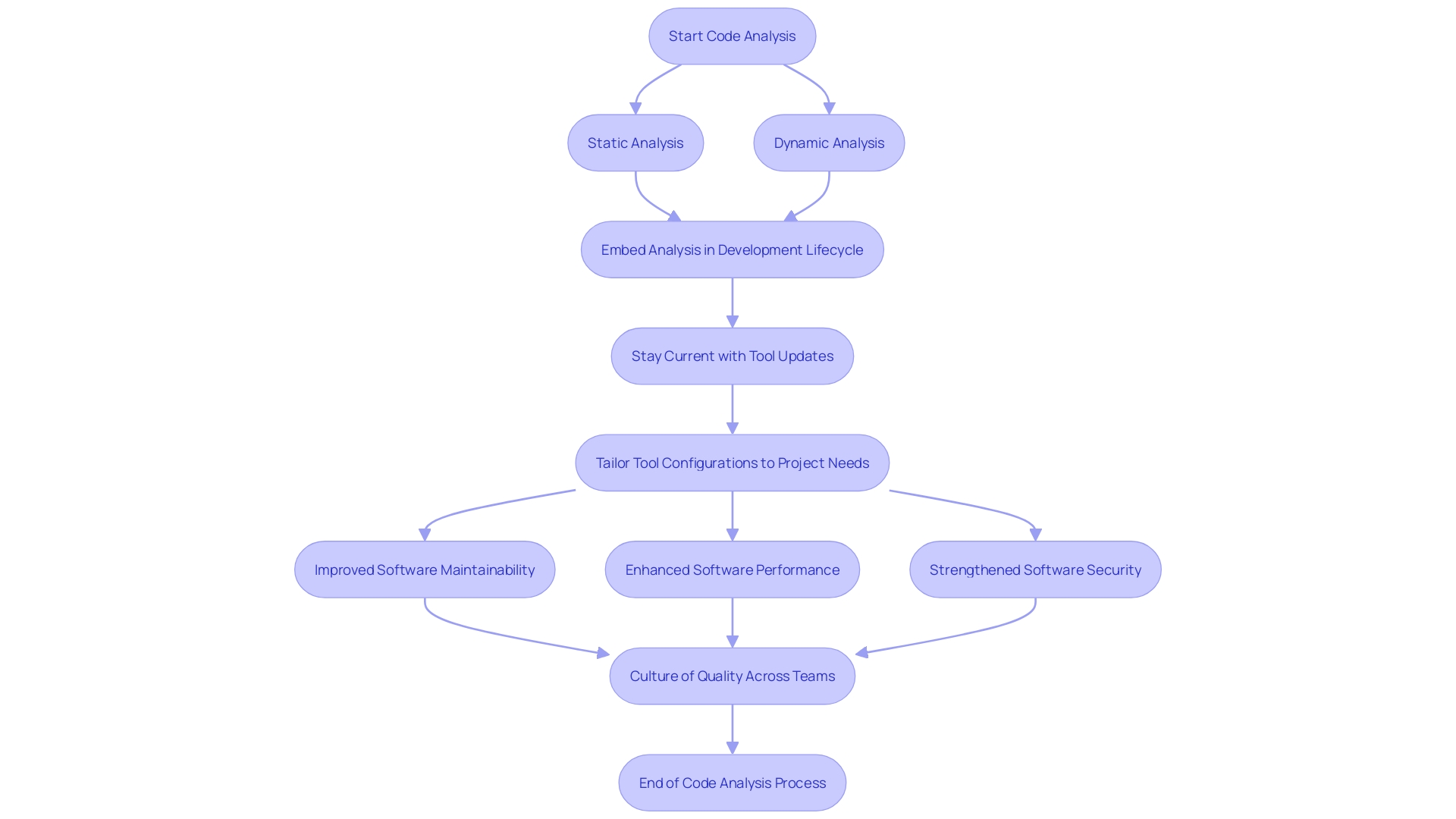
Conclusion
In conclusion, static and dynamic code analysis are essential techniques in software development that enhance code quality, reliability, and security. Static code analysis examines source code without execution, identifying defects, vulnerabilities, and coding standard violations. Dynamic code analysis observes code behavior during runtime, providing insights into performance issues and errors.
Static code analysis offers benefits such as early issue detection, automated analysis, consistent code quality, and improved security. It helps developers address problems early, enforce coding standards, and fortify code against vulnerabilities.
Dynamic code analysis provides critical insights into code behavior under different scenarios. It aids in performance optimization, error detection, and memory management. By replicating user environments, developers can optimize performance and ensure a seamless user experience.
Both static and dynamic code analysis have advantages and limitations. Static analysis may have false positives or miss issues, while dynamic analysis can introduce performance overhead and may not explore every code path. However, leveraging both approaches allows for comprehensive code quality.
In high-stakes industries like banking, static and dynamic code analysis play critical roles. Static analysis ensures continuous integration, coding standards enforcement, and security assurance. Dynamic analysis aids in performance optimization, error detection, and memory management.
When selecting code analysis tools, consider project requirements and programming languages. Static analysis tools like SonarQube and ESLint offer meticulous examination, while dynamic analysis tools like Valgrind and JProfiler scrutinize code during execution.
To maximize the benefits of code analysis, adopt best practices such as leveraging both methodologies, integrating analysis within the development lifecycle, staying updated with tool versions, and tailoring tool configurations.
By understanding the benefits of code analysis tools like Kodezi, developers and organizations can achieve maximum efficiency and productivity in their software development process. These tools are essential for creating robust, efficient, and secure software solutions, especially in high-stakes industries like banking.
Frequently Asked Questions
What is Static Code Analysis?
Static Code Analysis (SCA) is a process where the source code is checked for errors, vulnerabilities, and violations of coding standards without executing the code. It's similar to a proofreader who examines a written document for mistakes.
How does Static Code Analysis benefit software development?
SCA benefits software development by detecting potential defects early, enforcing coding standards, reducing the cost of bug fixes, and enhancing code security, reliability, and maintainability.
What is an example of Static Code Analysis in use?
M&T Bank is an example of an institution that has implemented Static Code Analysis to maintain clean code standards, improve software performance, reliability, and security, and to comply with regulatory requirements in the banking sector.
What is Dynamic Code Analysis?
Dynamic Code Analysis is a technique that involves observing the behavior of code while it is running. It is used to identify issues like memory leaks, performance problems, and error handling that may not be detected by static analysis.
Why is Dynamic Code Analysis important?
Dynamic Code Analysis is crucial for verifying that software behaves as expected under different conditions, ensuring system quality, spotting runtime issues, and optimizing performance.
What are the key differences between Static and Dynamic Code Analysis?
Static Code Analysis examines code without running it, focusing on structure and syntax, while Dynamic Code Analysis runs the code to identify runtime errors and performance issues.
What are the challenges associated with Static Code Analysis?
Challenges include the potential for false positives or negatives, lack of insight into runtime behavior, and the possibility of missing issues related to complex logic or external dependencies.
Can Dynamic Code Analysis experience limitations?
Yes, Dynamic Code Analysis can have execution overhead, limited code coverage, and difficulty in reproducing certain issues, which are all challenges developers must consider.
How do Static and Dynamic Code Analysis complement each other in software development?
Static Analysis is ideal for continuous integration and enforcing coding standards, while Dynamic Analysis is suited for identifying runtime errors and performance optimization. Together, they provide comprehensive code quality assurance.
What tools are available for Static and Dynamic Code Analysis?
For Static Analysis, tools like SonarQube, ESLint, and FindBugs are used. For Dynamic Analysis, tools like Valgrind, JProfiler, and Apache JMeter are common.
How should developers choose between Static and Dynamic Analysis tools?
Selection depends on the project's specific needs, the programming languages used, and the desired level of code coverage.
What best practices should be followed when using Static and Dynamic Analysis?
Best practices include leveraging both analysis types for thorough inspection, embedding analysis within the development lifecycle, staying current with tool updates, and tailoring tool configurations to project needs.
What is the impact of code analysis on industries with sensitive data like banking?
Code analysis helps organizations like banks to maintain high security, comply with regulations, and ensure the reliability and performance of their software, which handles sensitive data and transactions.
How does code analysis contribute to the quality culture within development teams?
Code analysis tools help in maintaining high standards of code quality, which supports a culture of excellence and continuous improvement within development teams.




